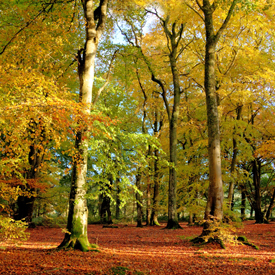Crackdown on infectious plant imports
Rules on plant and timber imports to the UK are to be tightened in an attempt to rid the country of alien diseases that have already killed millions of trees.
Border controls are to be beefed up and baggage allowances reviewed in a crackdown on alien tree diseases that threaten commerical forests and native ancient woodlands, under new plans to be unveiled by the government tomorrow.
In recent years, millions of Britain’s trees have been lost to pests and diseases introduced from overseas. More than 2,000 hectares of larch trees are curently being felled to prevent the spread of a fungus-like disease called phytopthora.
Just this month, forest scientists confirmed the first case of another phytopthora species killing cypress tress, thought to have arrived from south east Asia.

New inspections planned
Under Defra‘s tree health action plan, more personnel will inspect plant and timber products coming into the UK to ensure they are disease-free. The government will consult on new rules to restrict the type and amount of plant material travellers can bring into the UK and research into plant and tree diseases will also get a £7 million pound boost.
“Unless we get to grips with these serious tree diseases the landscape is going to be changed forever,” said Environment Secretary Caroline Spelman. “We’re coming under multiple attack now from exotic diseases that are skipping from plants to trees and from trees to trees and we could start to lose native tree species just as we did with elms through dutch elm disease.”
Unless we get to grips with these serious tree diseases the landscape is going to be changed forever. Caroline Spelman, Environment Secretary
An agressive form of dutch elm disease, which arrived from north America in the 1920s, has now killed an estimated 25 million of Britain’s 30 million elm trees.
Most of the imported diseases infect non-native trees like larch, horse chestnut or cypress, grown either for timber or as ornamental species. However, they can act as a stepping stone to ecologically important native trees: Beech, ash and oak trees can be killed by diseases like phytopthera. British oak trees are also under threat from oak processionary moth that was introduced from central Europe in 2006.
The greatest impact is in the south west of England where one third of all larch trees have been felled to control the spread of phytopthora. Larch is not only infected by the organism, but also helps it spread when spores form on the needles in the autumn, which are then blown long distances to infect other trees.
Disease often “impossible” to spot
Beginning last year, the Forestry Commission has been carrying out aerial surveys of their estate to spot larch trees infected with phytopthora. The disease starts in the crowns of trees and is often impossible to spot from the ground until the tree is completely dead.
As part of the action plan, research into plant and forest diseases are to be coordinated. The scourge of phytopthera was not spotted until it was quite established in British woodlands because the disease was only recocgnised as a pest of plants like rhododendron.
Though more money has been directed towards research, overall funding for forestry remains the same. The new initiative will put pressure on government research agencies, which are already suffering from job and funding cuts.
“We’re subject to the same constraints as everyone else. While our operational funding is not unaffected, we will always try to prioritise on research,” said John Morgan, head of plant health at the Forestry Commission.
If we get diseases that take hold in those woodlands, then we actually could lose something really irreplacable. Malcolm Allan, Woodland Trust
As the largest single owner of forests in the UK it is the Forestry Commission that will bear the greatest burden, but imported diseases pose a threat to native forests too.
“Our ancient woodland covers only about 2 per cent of the UK land area, it’s also very fragmented. So if we get diseases that take hold in those woodlands, and effect the small number of broadleaves that form the basis of those woodlands then we actually could lose something really irreplacable,”said Malcolm Allen of the Woodland Trust.
Tree diseases – new arrivals
Bleeding canker: horse chestnut
Phytopthora ramorum: larch but also beech, ash, oak and horse chestnut
Phytopthora lateralis: cypress
Massaria: London plane tree
Acute oak decline: oak
Oak processionary moth: oak
Horse chestnut leaf miner: horse chestnut
-
Latest news
-
Taylor Swift’s new break-up album breaks records3m

-
NHS trust fined £200K for failings that led to death of two mental health patients3m

-
Sunak vows to end UK ‘sick note culture’ with benefit reform3m

-
‘Loose talk about using nuclear weapons is irresponsible and unacceptable’, says head of UN’s nuclear watchdog3m

-
‘There wasn’t an Israeli attack on Iran,’ says former adviser to Iran’s nuclear negotiations team7m

-




